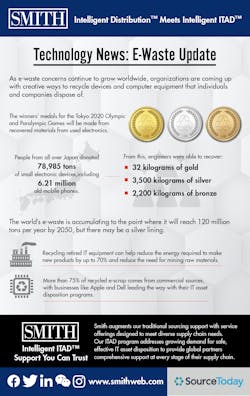Concerns over the high volume of electronic waste, or “e-waste”, that’s making its way into the world’s landfills, organizations are coming up with creative ways to recycle the many different gadgets, devices, and computer equipment that individuals and companies get rid of.
With Tokyo 2020 right around the corner, the organizing committee for the Olympic and Paralympic Games in Japan just revealed that the winners’ medals will be made from recovered materials from used electronics.
“Between April 2017 and March 2019, people all over Japan donated their small electronic devices, from which officials could recover the gold, silver, and bronze necessary,” Daniel Cooper writes in “Tokyo unveils its recycled e-waste Olympics medals”.
According to the committee, engineers recovered 32 kilograms of gold, 3,500 kilograms of silver, and 2,200 kilograms of bronze—95% copper and 5% zinc—from 78,985 tons of electronics. “That figure included a staggering 6.21 million old mobile phones,” Cooper adds, “handed over at NTT DoCoMo stores across the country.”
120 Million Tons by 2050
When consumer and business electronic equipment hits a certain point in its useful life, that equipment effectively becomes “e-waste.” With most people using more than six different network-connected devices, the world’s e-waste is accumulating to the point where it will reach 120 million tons per year by 2050.
Now valued at $62.5 billion—more than the GDP of most countries—worldwide e-waste figures are staggering. “More than 44 million tons of electronic and electrical waste were produced globally in 2017 – over six kilograms for every person on the planet,” the Platform for Accelerating the Circular Economy (PACE) and the UN E-Waste Coalition state in their 2019 report. “This is equivalent in weight to all the commercial aircraft ever built.”
A Silver Lining?
In many cases, e-waste actually contains more valuable metals by weight than raw ore does. This creates some interesting recycling and reuse opportunities. “By capturing those used phones, computers, printers, and even cables, recyclers can reduce the energy required to make new products by up to 70% and reduce the need for mining raw materials,” Mitch Ratcliffe points out in “e-Scrap Update: Continued Progress With a Chance of Disruption”. “Everyone can help achieve the goal of sustainable electronics production by separating e-waste and sending it to specialized e-waste recycling programs.”
The problem is that not everyone understands the recyclability of e-waste. In fact, a Pew Research report found that just 2% of respondents said that people in their communities are recycling e-waste. Business recycling leads the way, Ratcliffe adds, with more than 75% of recycled e-scrap coming from commercial sources.
Manufacturers like Apple, for example, are taking apart old products to recover whole components for reuse or specialized recycling. “After introducing its first iPhone-disassembly robot in 2016, the company has upgraded its process to tear down recycled iPhones with a robot called ‘Daisy’ that can breakdown 200 iPhones an hour,” Ratcliffe writes. “As computer and phone makers introduce programs to recapture their old products, the pace of recycling will continue to improve.”
Making Moves on the E-Waste Front
Last month, Dell announced that it had achieved is 2020 electronics recycling and recycled feedstock goals. In its 2019 sustainability report, the company outlined the performance of its e-scrap recycling and ITAD businesses, with key points including:
- Dell has recycled 2.1 billion pounds of e-scrap since the 2008 fiscal year, surpassing its goal of 2 billion pounds.
- Last year, Dell adopted BAN’s new EarthEye device tracking service to ensure that its recycling vendors are sending material to approved downstreams (i.e., those vendors that purchase and recycle electronics).
- Dell has a pilot project to rebuild hard drives so they can be reused (rather than shredded and recycled). It has generated $13 million to date and has diverted 303 tons from the recycling stream into the reuse stream, according to Dell’s report.
- Since 2014, Dell has used 100 million pounds of recovered materials in its products. The company met its goal of 100 million pounds during the first half of calendar year 2019.
Dell isn’t alone in its commitment to reducing e-waste. Integrated waste management company Blue Planet Environmental Solutions recently acquired e-waste technology company Smart Creative Technologies. Blue Planet says it will extend its technological capability and provide a sustainable solution to handle e-waste.
"E-waste is increasingly becoming a challenge and an opportunity in the region. Policymakers, industry leaders, and consumers are paying more attention to the current low-rates of recycling in Asia,” Blue Planet’s CEO Prashant Singh said in a press release. “They are looking for safe and sustainable processing technologies to ensure high resource recovery and safety for all those engaged.”
Global electronics maker Samsung is also doing its part to tackle the world’s mounting e-waste problem, Environmental Leader reports. In an interview with Mark Newton, head of North America corporate sustainability, the publication says Samsung collects and recycles about 100 million pounds of e-waste every year in the US alone.
“Our programs have been in operation since around 2008, and we’re actually on target to collect over 1 billion pounds this year,” Newton said. “We’re on track to collect about 8 billion pounds by 2020. We have a goal to collect and recycle 15 billion cumulative pounds of electronics globally by 2030.”











